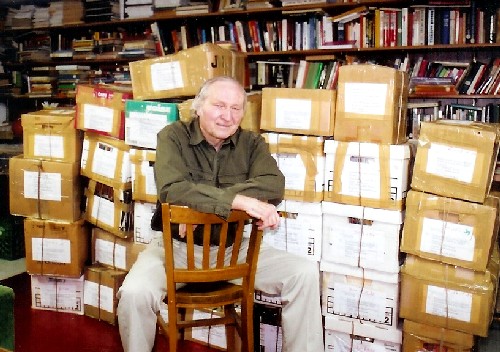Cold War mentality since the 1950s perpetuates mass hysteria which allowed for nuclear weapons to threaten our civilization. We became slaves of our politicians, the media and the military industrial complex. Today we ought to stand up and make our voices known that nuclear weapons ought to be banned.
 |
| Entrance sign. |
I went to see Russians perform in the program Beyond the Bomb: Music of the Cold War. I spent three-hours exploring its exhibits on four underground levels and hearing dozens of brief performances of music composed during the Cold War or that was inspired by the period.
 |
| Viktor Herbiet on sax in tunnel entrance |
Indeed. the venue gave me a vivid sense of how mass population can be herded like sheep to give up their civil rights and potentially their lives for some self-serving patriotic goal of preserving our kind — all in the name of freedom, democracy, and the moral right of the military industrial complex to kill for profit and power.
 |
| Construction of this four-level underground Cold War complex at Carp in 1960. |
Here's some facts I gathered:
- In 1958, Prime Minister John Diefenbaker announced in Canada's Parliament that '...development of a decentralized federal system of emergency government with central, regional and zonal elements would proceed' (Hansard, Aug 21, 1958).
- The basic principle was to protect and support key government services in case of massive nuclear attack on North America. Over the next decade up to 50 protective shelters were built across Canada. The Carp facility was the 'flagship', as it was expected to resist a blast of 5 million tons of TNT exploding at about a mile away, compared to all the others which were only designed for fallout; it was to provide shelter for 535 key people for up to 30 days. No provision was made for family members.
- The Carp facility cost $20 million (not including the special electronic telecommunications installed in 1962-63). Comprised of four levels underground, the walls of the building range from 2.5 feet to over 4 feet thick made of concrete with reinforced steel. Over 1,000 workers were employed on the site.
- The government ceased its responsibilities in the bunker in the fall of 1992 and the Department of Defence decommissioned the Carp site in December 1994. About this time, local community people purchased the facility for under $300,000 and begin operating it as a museum, largely using volunteer help. In June 1998, the bunker and some of the land surrounding it was declared a National Historic Site by Heritage Canada.
- The 20 million citizens of Canada were encouraged to build their own bunkers at an estimated cost of $4,000 in today's currency, but only about 2,000 were built. It was too much of an outlandish idea for the masses. People were more optimistic than their political leaders.
- See my 87 photos: Cold War Exhibit at Diefenbunker, and 17 photos posted by another person who also attended: Beyond the Bomb: Music of the Cold War.
Only to the credit of the Cold War superpower leaders, US President John F. Kennedy and Soviet Premier Nikita Krushchev, as well as the United Nations, the world was saved.
Sergei Krushchev, the son of Nikita Krushchev, explained how all this happened when he watched the crisis unfold at his father's side.. He spoke to Jim Brown of CBC Radio (October 19, 2012) from Brown University where he is Visiting Professor. Sergei pointed out that his father had no choice but to send nuclear missiles to Cuba. Because the USA was planning to invade Cuba, the USSR needed to protect Cuba.
Both leaders understood that their goal was to avoid a nuclear conflict because this would lead to the end of the world. To do this, they did not wish to allow the military to be part of their agenda. They both figured out a way to create a win-win outcome.
The end of this video clip (at time 1:26) shows Sergei Krushchev explaining that both the USA and the USSR were mirror images of the 'evil empire'. See: Cuban Missile Crisis - Three Men Go To War, PBS TV, October 23, 2012.
In the end, luckily all of us were winners.
Today, fifty years after the missile crisis, the Cold War mentality continues. We need to remember that many of the old missiles are still in their silos ready to be launched. The end of the world could come to an end if we don't take steps to get rid of these weapons of mass destruction once and for all. The Physicians for Global Survival underline this in their mission statement. Let's get on with it!
Atomic weapons are weapons of mass destruction. They do not distinguish good from bad people. We are all equally subject to be killed by its devilish powers. For this Fiftieth Anniversary let's rededicate our efforts to ban these weapons from the face of the earth. In fact, let's make wars a crime against humanity! Consider our culture of peace mantra as creating a 'nonkilling society' and one of our goals as building Departments of Peace in every country.
More about "Beyond the Bomb: Music of the Cold War"
- My 87 photos: Cold War Exhibit at Diefenbunker
- Review by Diana: View from the Diefenbunker
- Victor Herbiet Diefenbunker Video
